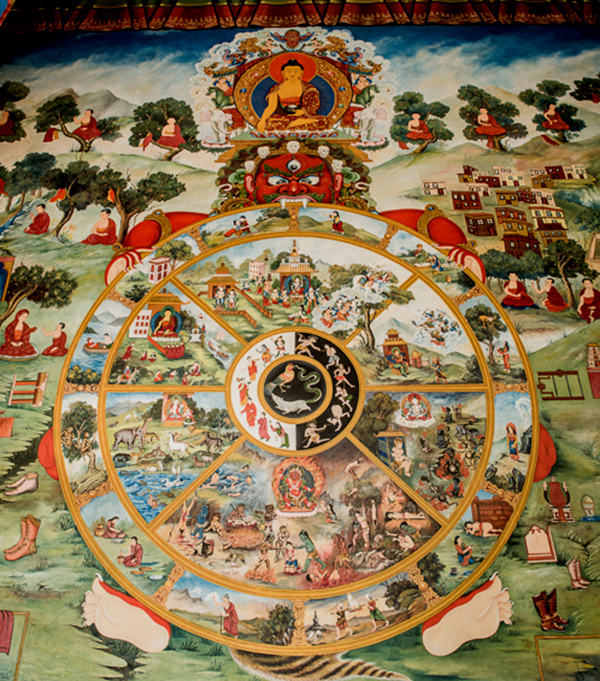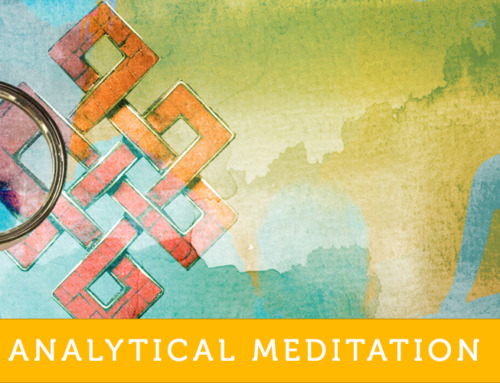This excerpt is copyrighted material, please do not use or copy without written permission from Nitartha Publications.
This excerpt is taken from our ebook that we are giving away this year, Analytical Meditation: Taming the Mind. Please sign up here to receive this detailed, 20-page ebook on analytical meditation by Dzogchen Ponlop Rinpoche.
Meditation On Repulsiveness
Dzogchen Ponlop Rinpoche
We are human beings, one of the six classes of sentient beings who live in the desire realm of the three realms of samsara. Since we live in the desire realm, desire is foremost among the mental afflictions for us. All the other mental afflictions, such as aggression, bewilderment, pride, and jealousy, arise on the basis of this fundamental mental affliction. It is not that we do not have the other mental afflictions, but the ground for all mental afflictions is desire.
From the Sutrayana perspective, the main method to purify the mental activity of desire is the meditation on repulsiveness. The meditation on repulsiveness mainly concentrates on the body as the object of repulsiveness. You start off by contemplating the nature of your body, and if you find that you have any attachment and clinging to your body, you then contemplate the repulsive nature of your body. From there, you expand your contemplation outward to the bodies of others and so on, whatever you might be attached to. When you contemplate your own body, you think about how what makes up your body now is something that you have to leave behind in the end.
From the Buddhist point of view, the body is actually like a motel or a hotel. Whether you stay in a shitty motel that smells bad or whether you stay in a fancy hotel that has really nice soap and Aveda shampoo, it is the same thing. Nothing belongs to you. You are there as a guest, and from that perspective, there is no difference. You can take care of that room, or you can trash it, like Eddie Van Halen did because they gave him green M&Ms. But do you really want to live in a trashed room? Even if you are living in a shitty motel room, if you take care, it can be nice. In the same way, as long as you live in this motel called this body, this life, and so on, if you take care, it will be nice, and there is nothing wrong with that. At the same time, it is impermanent, and sooner or later, you will have to leave this motel. Sooner or later, someone will take your body to a mortuary. In Tibet, the vultures take care of it.
From the Buddhist point of view, the body is actually like a motel or a hotel. Whether you stay in a shitty motel that smells bad or whether you stay in a fancy hotel that has really nice soap and Aveda shampoo, it is the same thing. Nothing belongs to you. You are there as a guest, and from that perspective, there is no difference. You can take care of that room, or you can trash it…
As an antidote to our clinging and attachment to our own body, we meditate on repulsiveness. This way of meditation is from the common or foundational vehicle of Buddhism, and three main meditations are practiced at this stage. The first type is the meditation on filthiness, the second type has the name of the overall category so it is called the meditation on repulsiveness, and the third type is the skeleton visualization, the skeleton being the main basis upon which the body is built. I will not be explaining the detailed explanation of these three meditations in this class. The practices may sound very weird, but they are profound in the sense that they are great mind training practices. It is all about mind training—mind training, mind purification, mind transformation.
In sum, as a method for purifying the mental activity of desire, we meditate on repulsiveness. Even though we may meditate on repulsiveness, we will not be able to completely relinquish the mental affliction of desire. Nevertheless, if we thoroughly practice this meditation, it is taught that it will stamp down the manifest forms of desire. We might not get all desire, including its latent or dormant forms, but we will be able to stamp down the manifest forms of desire.
The collection of instructions about these meditations for purifying the mind is known as the “upadeshas” or “pith instructions” for purifying the mind. It is also called “mind purification” or “lojong.” It is important to think about the name of this collection of teachings: instructions for purifying the mind. These are instructions that help us overcome our thoughts and different forms of fixation. They do not have anything to do with the objects we think about, the outer objects themselves, but they instruct how to purify our own mind inside.
These meditations are not about how ugly someone looks or how repulsive someone may be. They are about our attachment and how our attachment is ugly and repulsive. In the end, it is our attachment that is disgusting. Whether we have a beautiful object or whether we have a not so beautiful object, our attachment is the same, and it is our attachment and desire that bring pain to ourselves and others. In my opinion, whether we are contemplating filthiness or contemplating repulsiveness or visualizing skeletons, all are simply ways to relate to the attachment and clinging found in our own mind.
Although the basic structure of a skeleton does not have a label or name, once it is covered with flesh and so on, we put all kinds of labels on top of it. From there come many concepts, thoughts, ideas, and attachments that have nothing to do with reality. Even when we talk about our parents, children, and partners, we project and label on top of their basic skeletons. The actual reality of who they are is like a skeleton. Then, on top of that skeleton, we cover them with body and flesh—all of our projections, thoughts, and so forth—and we build something totally different other than who they actually are. On the basis of that skeleton, we generate many emotions, thoughts, attachment, and clinging. That mind is what is ugly, disgusting, and repulsive. That is what the teaching on repulsiveness really means for me.
Of course, in our meditation practice, we use different techniques to create and bring on this feeling of repulsiveness and ugliness. In that way, meditation is a bit like CGI. It has to be more creative and graphic in order to gross out and entertain people, like in “True Blood” and “Dexter.” In the same way, meditation is sometimes exaggerated, so that it makes you feel disgusted. Since the meditation on repulsiveness is so graphic, it has an “R” rating. If you are a minor, please close your eyes and ears! The meditation on ugliness, repulsiveness, and filthiness is quite graphic in order to bring on the feeling of how disgusting our thought process and labeling mind is. That labeling has nothing to do with the basic skeleton of reality. The basic skeleton of reality is totally different from what we put on top of it. When this kind of meditation is taught traditionally, people usually think it is weird and do not want to do it, but if you think about it, it is a profound and beneficial meditation, as it shows us how disgusting our labeling mind actually is.
Sometimes when you think someone is upset with you, and you wonder why he or she is not talking to you, you think that this person looks differently at you now. We have all kinds of projections. Why is she being like that? Maybe it’s because I did this or that, but when you finally have a chance to talk to that person, she says, “Oh, I have been so busy, and I didn’t have time to call you,” or she says, “I have been having a really difficult time with my work and haven’t had time to call anyone.” In the end, it has nothing to do with you or any of your projections that you have been suffering over for the past week. This is how our projections bring us so much suffering and pain. It is disgusting.
When you think about this matter carefully, you might reach the conclusion that there is no choice not to feel repulsiveness or no choice not to have an insight into filthiness, and that is why in the traditional context contemplating repulsiveness is presented in the beginning. It is very graphic, but this type of technique is needed to enhance our relationship to this contemplation on repulsiveness, such as contemplating the list of the thirty-six filthy substances of the body and so on.
At the beginning, it is a bit like a picture dictionary, but later you can just read the words and definitions, and you no longer need the pictures. After that, you can look to the synonyms and antonyms, and you do not need the definitions. So, there is a progression. In the beginning, you need a graphic dictionary of ugliness and repulsiveness; however, these things are not needed in the context of the final form of meditation. They are simply skillful means to purify and tame our mind. In the beginning, our mind is overwhelmed with the conceptual movement of thoughts, and in order tame the mind, we practice shamatha that focuses on the breath. Next in order to relate to our emotional mind, particularly that of desire, we begin by practicing the meditation on repulsiveness, but all of these are simply methods for taming and purifying the mind, as opposed to being called methods for taming and purifying objects. It is not about changing what you see out there, it is about changing how you see it.
Meditation Practice
There is a nice verse that reminds us of the context and intention through which these teachings are being given to us. The verse says:
All of the great many dharma ways of the victorious One,
Infinite in their reach
Are nothing other than methods
For taming our own mind-stream.
Please contemplate this verse well. Remember it and memorize it.





